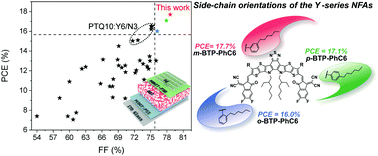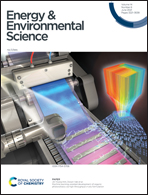Fine-tuning of side-chain orientations on nonfullerene acceptors enables organic solar cells with 17.7% efficiency†
Abstract
Side-chain engineering has been shown to be an important strategy to optimize Y-series nonfullerene acceptors (NFAs). Most previous reports were focusing on changing the branching positions and size of the alkyl side chains on Y6. In this paper, we investigate the influence of the orientation of side chains on the properties of NFAs and the performance of the organic solar cells (OSCs). Three isomeric NFAs named o-BTP-PhC6, m-BTP-PhC6, and p-BTP-PhC6 are designed by changing the substitution positions and thus orientations of the side chains attached to the central core. Our studies show that the optimal side-chain orientation can be achieved by the meta-positioned hexylphenyl group (of the m-BTP-PhC6 molecule), which introduces significant beneficial effects on optical absorption, intermolecular packing and phase separation of the NFAs. By pairing a donor polymer PTQ10 with m-BTP-PhC6, device efficiencies of 17.7% can be achieved, which is among the best values for PTQ10-based nonfullerene OSC devices so far. These results reveal that regulating side-chain orientations of Y-series NFAs is a promising strategy to achieve favorable morphology, and high charge mobility and solar cell performances.



 Please wait while we load your content...
Please wait while we load your content...